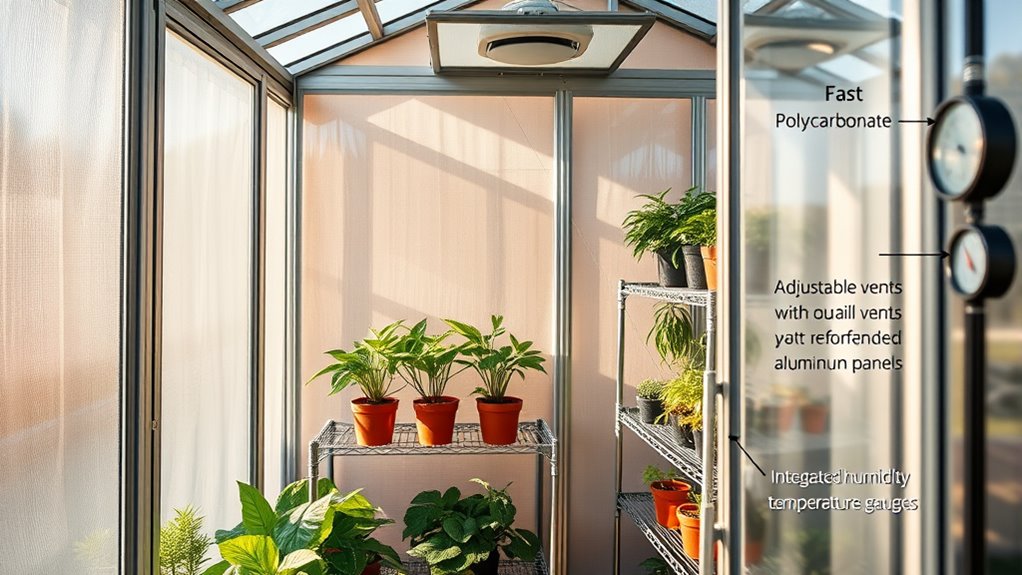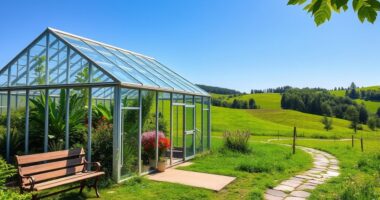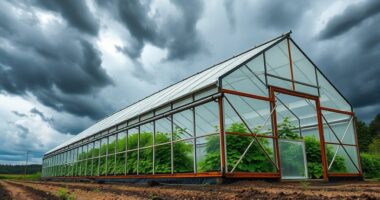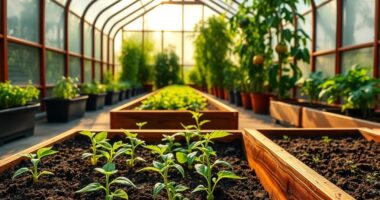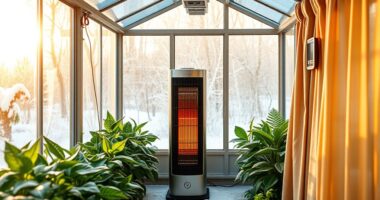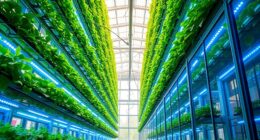When choosing a greenhouse kit, focus on matching the size to your available space and gardening goals. Check the material quality for durability against weather, and make certain it offers good ventilation and climate control features to keep plants healthy. Look for easy assembly, stable framing, and thoughtful internal organization like shelves. Don’t forget to think about accessibility and extra features that can boost growth. Continue exploring to discover tips that help you pick the perfect fit for your gardening journey.
Key Takeaways
- Match greenhouse size and features to your available space and gardening needs for optimal growth.
- Prioritize durable, weather-resistant materials like galvanized steel and UV-resistant panels for longevity.
- Ensure effective climate control options such as ventilation, automatic fans, and sensors for healthy plant development.
- Choose accessible designs with secure doors and proper placement of entry points for ease of use.
- Verify compatibility of features like heating, lighting, and shelving to enhance gardening efficiency and future expansion.
Size and Space Requirements
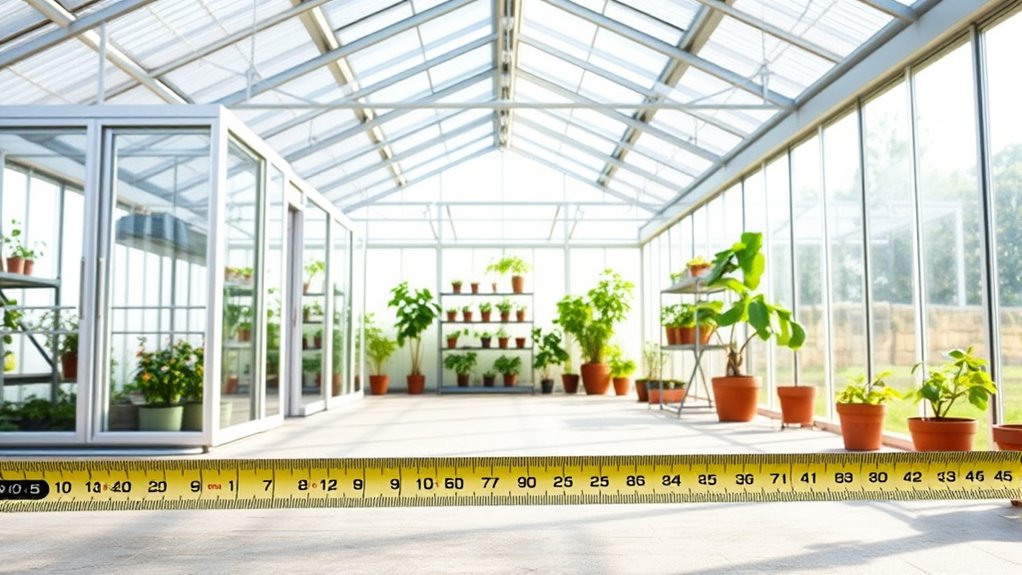
Choosing the right greenhouse kit depends largely on the size and space you have available. You’ll need to contemplate your plant spacing needs to ensure your plants have enough room to grow without overcrowding.
Selecting a greenhouse kit that matches your space ensures healthy plants and comfortable gardening.
A compact footprint is ideal if you have limited space, allowing you to maximize your area efficiently. Measure your available space carefully and compare it to the greenhouse’s dimensions. Proper planning can help prevent overcrowding, which can hinder plant growth and airflow.
Larger kits offer more room for diverse plant varieties and easier access, but they require more space. Smaller, space-saving models suit hobbyists or those with limited yards.
Think about how much room your plants need and how often you’ll tend to them. Proper planning ensures your greenhouse fits comfortably in your space, supporting healthy plant growth without feeling cramped.
Additionally, considering greenhouse ventilation is essential to maintain proper airflow and temperature control, promoting healthy plant development. Proper ventilation can also prevent issues related to air circulation, which is vital for preventing plant diseases and ensuring an optimal growing environment.
Material Quality and Durability
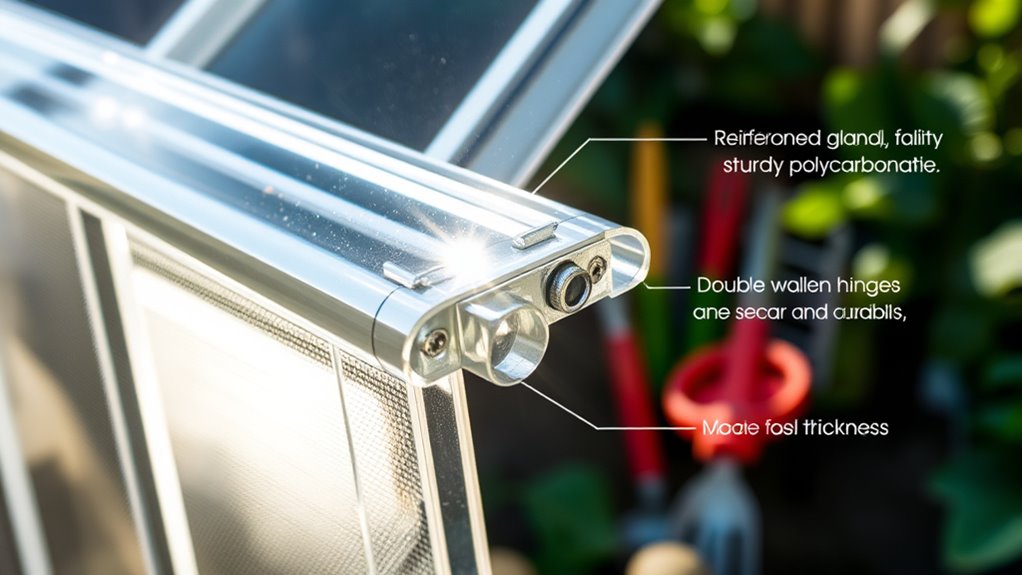
The durability and quality of materials directly impact the longevity and performance of your greenhouse kit. You want materials with high material strength that can withstand daily use and environmental stress. Look for sturdy framing options like galvanized steel or heavy-duty aluminum, which offer excellent weather resistance and won’t easily warp or corrode. The panels should be made from tough, UV-resistant polycarbonate or tempered glass, ensuring they resist cracking and fading over time. Weather resistance is essential; your greenhouse needs to endure rain, wind, and snow without deterioration. Investing in high-quality materials means your greenhouse remains stable and functional for years, reducing maintenance costs and preventing early replacements. Additionally, choosing materials with corrosion resistance helps maintain the structural integrity over time and minimizes repairs. Selecting materials with proven durability standards ensures your greenhouse can handle harsh weather conditions and prolongs its lifespan. Considering material certifications can further guarantee the quality and safety of your materials. Prioritize material quality and durability to get the most value and reliable performance from your investment. Incorporating weather-resistant materials further enhances the lifespan and resilience of your greenhouse against environmental challenges.
Ventilation and Climate Control
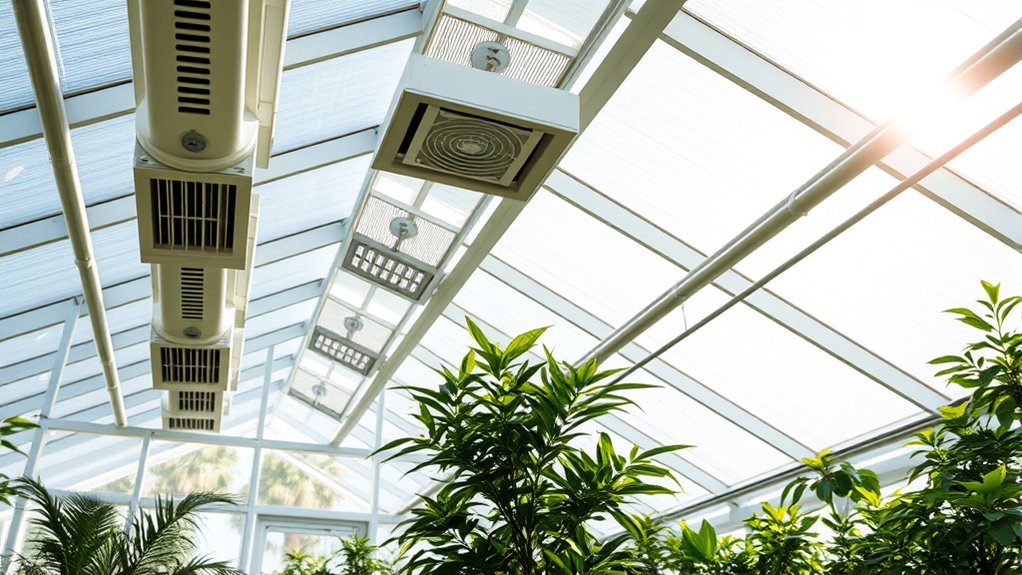
Effective ventilation and climate control are essential for maintaining healthy plant growth inside your greenhouse. Proper systems prevent overheating, humidity buildup, and stagnant air. When choosing a greenhouse kit, consider these key features: 1. Ventilation systems that include automatic exhaust fans or side vents for airflow regulation. 2. Climate sensors that monitor temperature and humidity, providing real-time data. 3. Adjustable vents or fans to customize airflow based on plant needs. 4. Integration of sensors with automated controls for consistent climate management. These features work together to create an ideal environment. Proper ventilation systems ensure fresh air circulation, while climate sensors help you respond quickly to changing conditions. Maintaining proper airflow is crucial to prevent issues like mold or disease that can arise from poor air quality. Additionally, selecting systems with automated controls can help maintain stable conditions with minimal manual intervention. Incorporating climate monitoring tools allows for more precise adjustments and healthier plant growth. Understanding the importance of automation in climate control can further optimize the environment for your plants. Moreover, considering energy efficiency in your systems can reduce operational costs while maintaining optimal conditions. Focus on these aspects to promote healthy plant growth and avoid issues caused by poor air quality or temperature fluctuations.
Ease of Assembly and Portability
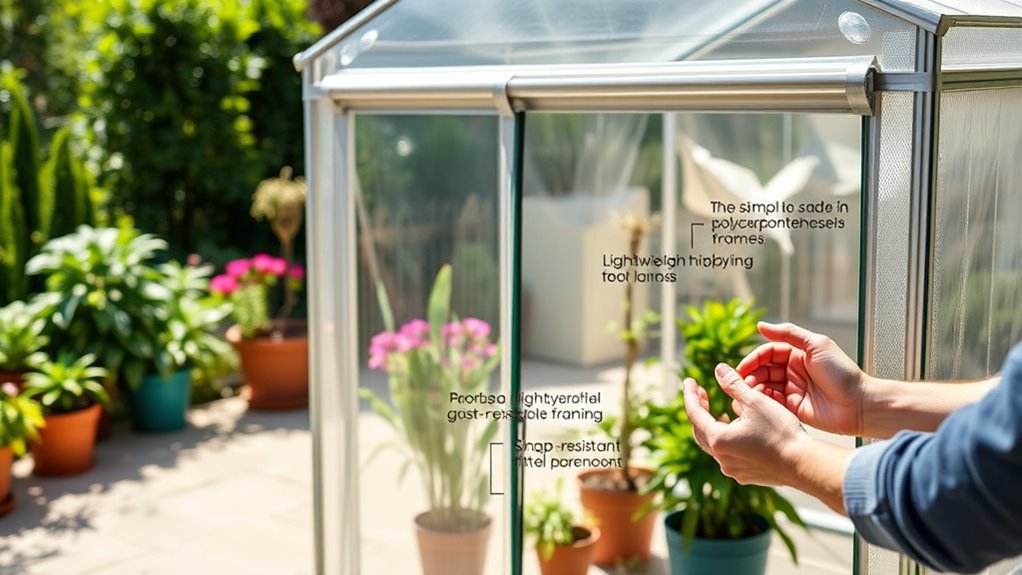
Setting up your greenhouse should be straightforward, so consider how much time the assembly takes. A kit with simple instructions and minimal parts makes the process quicker and less frustrating. Additionally, choosing a self-watering system can reduce the frequency of watering, making maintenance easier. Plus, a lightweight frame lets you move and adjust your greenhouse easily whenever needed. Selecting a durable frame material ensures your greenhouse remains sturdy over time, even with frequent relocation. When selecting a kit, also consider options that include space-saving features to maximize usability in smaller areas. Ensuring the components are easy to assemble will help prevent delays during setup and make the process more enjoyable.
Assembly Time Requirements
Assembly time for greenhouse kits varies widely, but most models are designed for straightforward setup to save you time and effort. When evaluating, consider these factors:
- How clear and detailed the assembly instructions are, ensuring you can follow them easily.
- The estimated setup time provided by the manufacturer, helping you plan accordingly.
- Whether the components are pre-drilled or require additional work during assembly.
- The number of people needed to assemble the greenhouse efficiently.
A quick, simple setup minimizes frustration and allows you to start gardening sooner. Look for kits with detailed, step-by-step instructions and reasonable setup times to ensure a smooth assembly process. Efficient assembly can also enhance your remote work productivity by reducing stress and freeing up time for gardening or other hobbies. Additionally, considering the portability of the kit can make it easier to relocate or store the greenhouse when needed. This saves you time and helps ensure your greenhouse is sturdy and functional, especially since the cultural impact of easy-to-assemble kits can influence overall satisfaction.
Lightweight Frame Design
A lightweight frame design makes greenhouse kits easier to assemble and move around, especially if you need to adjust their location or transport them.
A portable design ensures you can relocate your greenhouse without hassle, which is ideal for changing seasons or optimizing sunlight.
Weight reduction is a key benefit, allowing you to handle the structure more comfortably and reducing the need for heavy equipment.
This ease of assembly and movement is especially useful if you plan to store the greenhouse during off-seasons or relocate it frequently.
When choosing a kit, look for lightweight materials like aluminum or sturdy plastics that maintain durability while keeping the overall weight low.
A well-designed, lightweight frame enhances flexibility, making your gardening experience more convenient and adaptable.
Frame Construction and Stability

Your greenhouse’s frame needs strong, durable materials to withstand weather and time. Reinforcements and support systems are essential for maintaining stability, especially in windy areas.
Choosing the right combination of materials and structural support ensures your greenhouse stays secure and functional.
Frame Material Durability
The durability of a greenhouse kit’s frame material directly impacts its stability and longevity. You should prioritize frame materials with strong corrosion resistance to withstand weather exposure.
Consider these key factors:
- Material type – Aluminum, steel, or PVC each offers different levels of durability.
- Corrosion resistance – Look for coated or treated frames that resist rust.
- Thickness and gauge – Thicker frames generally provide better stability.
- Maintenance needs – Some materials require minimal upkeep to stay durable.
Choosing a frame material with high corrosion resistance ensures your greenhouse remains sturdy over time, even in humid or rainy environments.
This focus on durability helps maximize your investment and keeps your plants protected for years to come.
Reinforcement and Support
Ensuring proper reinforcement and support is essential for maintaining the stability of your greenhouse. Look for strong support structures that can withstand wind, snow, and other weather conditions.
Frame reinforcement adds extra strength to prevent bending or buckling over time, especially in larger structures. Metal or heavy-duty materials are typically better for reinforcement than lighter options.
Consider cross-bracing or additional supports at joints to enhance stability. Properly designed support structures distribute weight evenly, reducing stress on individual components.
A well-reinforced frame not only resists environmental stresses but also ensures your plants are safe and your greenhouse remains durable. Investing in quality reinforcement and support will prolong the life of your greenhouse and keep it standing firm for years.
Covering Materials and Light Transmission
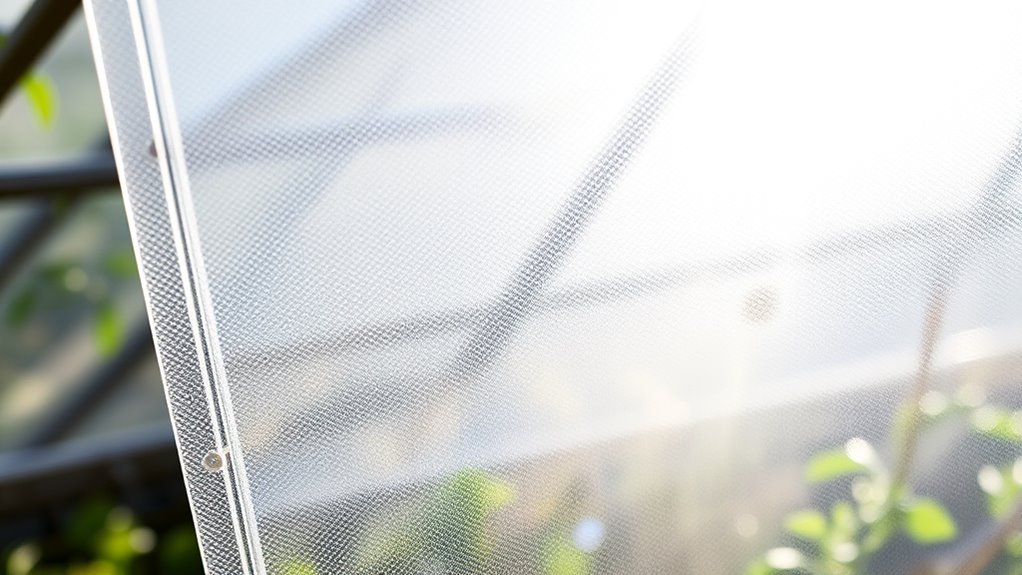
Have you ever wondered how the choice of covering materials affects the amount of light that reaches your plants? The right material balances light transmission, UV protection, and thermal insulation.
Consider these options:
- Polycarbonate panels: Offer high light transmission, excellent UV protection, and good thermal insulation.
- Glass: Provides maximum clarity, strong UV protection, but less insulation.
- Polyethylene film: Cost-effective, with decent light transmission; UV protection varies.
- PVC or acrylic: Durable and lightweight, with varying levels of UV protection and insulation.
Choosing the right material ensures your plants get enough light while protecting them from harmful rays and temperature fluctuations.
Prioritize UV protection and thermal insulation to optimize growth and energy efficiency inside your greenhouse.
Shelving and Internal Organization

You can customize your greenhouse with adjustable shelving options to fit different plant sizes and tools.
Efficient space use is key, so consider strategies like stacking or tiered shelves to maximize every inch.
These organization tips help create a tidy, productive environment for your gardening needs.
Adjustable Shelving Options
Adjustable shelving options are essential for maximizing the versatility of your greenhouse kit. They allow you to create customizable storage that adapts to your plants’ needs.
With adjustable shelving, you can easily change shelf heights to accommodate taller plants or equipment. Here are four key benefits:
- Flexibility to customize shelf spacing for different plant sizes
- Efficient use of space by adjusting shelves as your garden grows
- Easy access to plants and tools with adjustable configurations
- Enhanced organization, making it simple to locate what you need quickly
Space Optimization Strategies
Effective space optimization within your greenhouse hinges on strategic shelving and thoughtful internal organization. By using vertical gardening techniques, you can maximize limited space, allowing you to grow more plants vertically rather than spreading out horizontally.
Install adjustable or tiered shelving to create multiple levels for seedlings, herbs, or small plants, which enhances efficiency and accessibility. Incorporate aesthetic enhancements like decorative shelves or colorful containers to make the space inviting.
Organizing tools, fertilizers, and supplies in designated storage keeps the area tidy and frees up valuable space. Consider wall-mounted racks or hanging baskets to utilize every inch of available space.
These strategies not only improve plant growth but also make your greenhouse more functional and visually appealing.
Access Points and Door Design

Choosing the right access points and door design is essential for guaranteeing easy entry and exit while maintaining the greenhouse’s internal environment. Proper design enhances access convenience and door security, preventing unauthorized entry.
When selecting doors, consider these key factors:
- Location: Place doors where they minimize disruption and maximize accessibility.
- Size: Ensure doors are large enough for equipment, plants, or tools to pass easily.
- Material: Use durable, weather-resistant materials for longevity and security.
- Locking Mechanisms: Choose secure locks that prevent unauthorized access but allow easy opening for users.
Price and Warranty Options
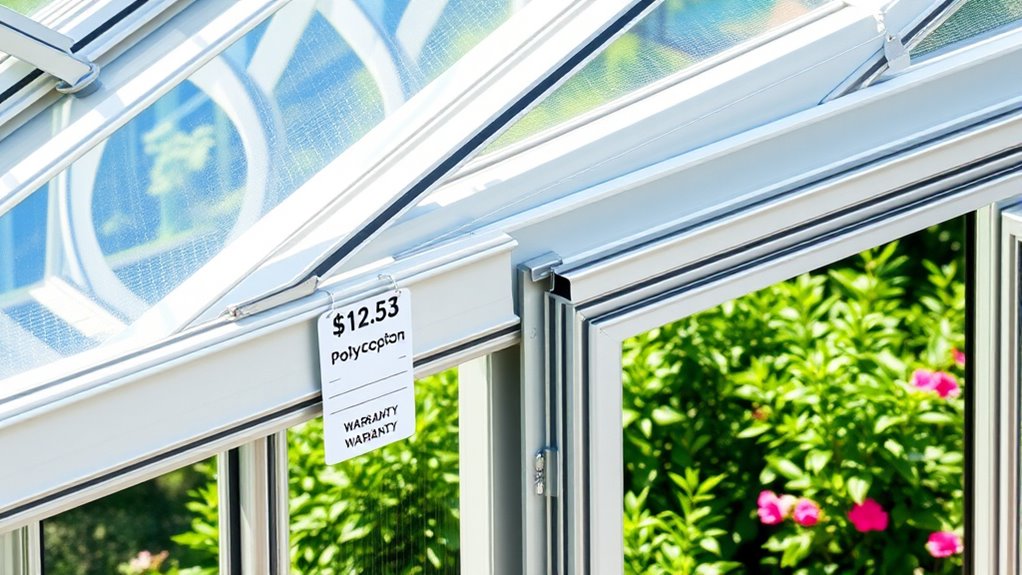
When selecting greenhouse kits, considering price and warranty options helps you balance quality with your budget. Look at the various pricing options available—some kits offer basic features at a lower cost, while premium models include extra durability and features.
Be sure to compare warranty coverage; a longer warranty often indicates confidence in the product’s durability and can save you money on repairs later. Check what the warranty covers, such as frame integrity, glazing, or hardware, and how long it lasts.
While a lower price may seem attractive, ensure the warranty provides sufficient protection for your investment. Ultimately, choosing a kit with fair pricing options and all-encompassing warranty coverage ensures you get a durable greenhouse that meets your needs without unexpected expenses.
Additional Features and Accessories
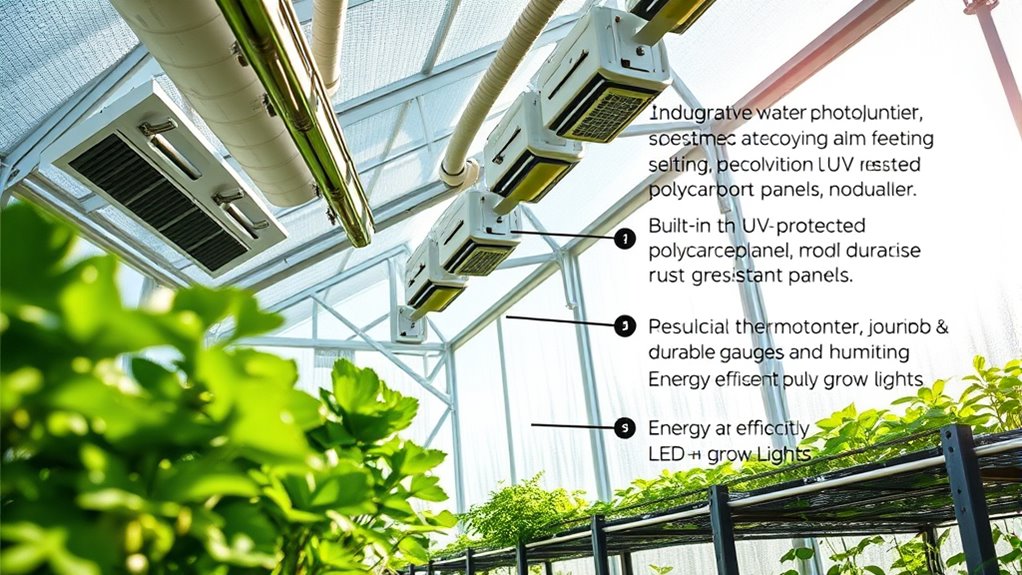
Adding extra features and accessories to your greenhouse kit can enhance its functionality and convenience. These additions improve plant health and simplify maintenance. Consider these options:
- Ventilation systems to regulate temperature and humidity efficiently.
- Automated watering accessories to ensure consistent moisture levels.
- Shelving units for better organization and space utilization.
- Shade cloths to protect plants during intense sunlight.
Ventilation systems help prevent mold and overheating, while watering accessories make irrigation effortless. Shelving maximizes space, and shade cloths maintain ideal growing conditions.
Choosing the right accessories depends on your plants’ needs and your climate. Investing in these features can considerably boost your greenhouse’s performance and your gardening experience.
Always verify compatibility with your kit to ensure a seamless setup.
Frequently Asked Questions
How Energy-Efficient Are Different Greenhouse Kits?
When comparing greenhouse kits, you’ll find their energy efficiency varies based on solar efficiency and insulation quality. Kits with high solar efficiency maximize sunlight, reducing heating needs.
Good insulation keeps warmth in during colder months. Look for features like double-pane panels or thermal curtains that enhance insulation.
What Maintenance Is Required for Long-Term Use?
You might wonder what it takes to keep your greenhouse thriving long-term. Regular plant watering is essential, ensuring your plants stay healthy and vibrant.
Don’t forget pest control—timely checks prevent infestations from ruining your crops.
Consistent cleaning and monitoring help maintain *ideal* conditions. Stay vigilant, and your greenhouse will reward you with abundant growth.
Keep up with these simple tasks, and your greenhouse will remain a productive haven for years to come.
Are There Eco-Friendly or Sustainable Options Available?
Yes, eco-friendly options are available when choosing a greenhouse kit. Look for kits made from eco-friendly materials like recycled or sustainably sourced wood and metal.
Sustainable design features, such as energy-efficient glazing and natural ventilation, help reduce your environmental impact. By selecting these options, you support environmentally responsible practices while ensuring your greenhouse is durable and efficient.
These choices make your gardening more sustainable and eco-conscious.
How Do I Choose the Right Size for My Plants?
You might think choosing the right greenhouse size is straightforward, but it’s all about plant spacing and growth potential. Research shows that giving your plants enough room encourages healthy development and maximizes yield.
Measure your plants’ mature size and consider how many you want to grow. A larger greenhouse offers more flexibility, but if space is limited, opt for a size that balances plant needs and your gardening goals.
What Safety Features Should I Consider in a Greenhouse Kit?
When choosing a greenhouse kit, you should prioritize safety features like reliable locking mechanisms to prevent unauthorized access and guarantee security.
Additionally, look for effective ventilation systems to maintain proper airflow, which helps control temperature and humidity, reducing risks like mold or pests.
These features protect your plants and keep your greenhouse safe, making your gardening experience more enjoyable and worry-free.
Conclusion
By choosing the right greenhouse kit, you’ll turn your gardening dreams into a lush, thriving jungle that rivals the Amazon itself. Imagine stepping into a mini rainforest right in your backyard, with perfect climate control and sturdy, long-lasting materials holding back the elements. With the right features, your plants will flourish like a botanical wonderland, making every gardening day feel like an adventure in paradise. Don’t settle—create a green oasis that blows everything else out of the water!
